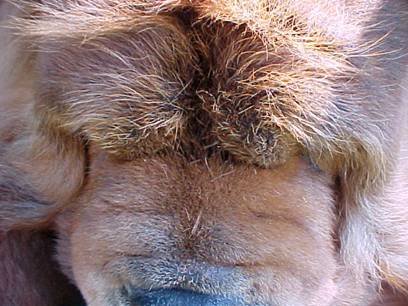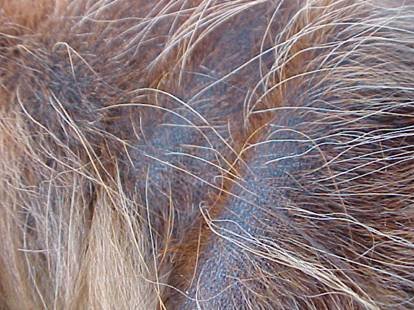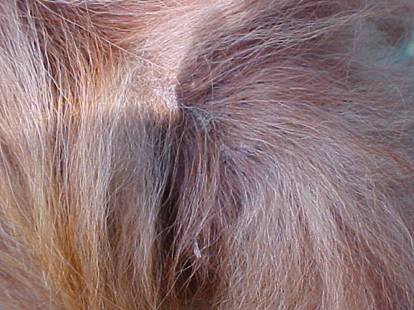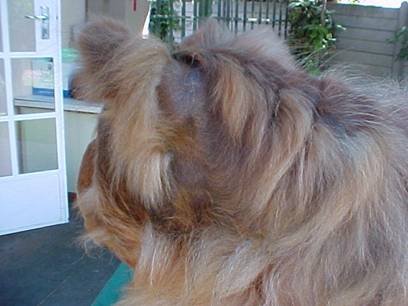Presented at the International Health Congress in Slovenia in 2005
First published in the international publication by Bas Bosch "The World of Chows" 2005/2006 (ISBN 978-90-767-18-0)
SEBACEOUS ADENITIS:
The testing of any breed of dog for health issues related to the breed is important. It is also our responsibility as custodians of the breed to ensure that this is done and documented.
My topic of health will be sebaceous adenitis. It is a subject that has far better and broader documentation in other breeds (for example poodles, akitas, samoyeds) than in the chow chow. My thanks to the many people in the other breeds that have helped me with information and guidance on this disease.
Sebaceous Adenitis (SA) is a hereditary autoimmune skin disease whose mode of inheritance is believed to be simple autosomal recessive, requiring a single defective gene from the sire and the dam. SA is not sex linked. A genetic disease of this type cannot be cured, but can be treated and can be bred away from. It is a progressive skin disease, quite easy to misdiagnose and can develop at any age.
SA has been diagnosed in many breeds, of which the chow chow is one, and in the chow chow not much research has been carried out - because it has usually been misdiagnosed and then hidden. SA usually develops in younger dogs, but it can also develop at a later age. A parent of the SA dog may or may not show the clinical symptoms, being what is known as sub clinically affected, meaning that some inflammation may exist but has not progressed to destruction of the glands and the subsequent loss of hair. They may be described as having some skin allergies, but they are carriers. It is also common that neither of the parent's do not have skin allergies.

WHAT HAPPENS:
In SA the sebaceous glands that adjoin the hair follicles become inflamed and are gradually destroyed. The symptoms of SA can resemble allergies and can go misdiagnosed for quite a long time
WHAT SYMPTONS ARE USUALLY SHOWN:
The most common symptoms are excessive dandruff or scaling and hair loss, which ranges from mild to severe. The hair loss is usually patchy giving a moth eaten look. Itchiness is not indicative of SA but can accompany the secondary skin infections, which usually are accompanied by a musky odour and may flare up periodically.
-Yellow flaky skin, flaky ears neck and tail, massive flaking, dry scaly skin, scaling on the nose excessive dandruff and scales
-Skin wrinkly and black, skin grey and dry, dark skin spots itchy scaly skin over the top, grey scaly patches, black scales, black clammy skin, dusty appearance on muzzle, entire loss of undercoat with widespread infection, blackened hair follicles, fungal-looking area on nose
- Crusty, frayed ears, crusty lumps on rear, torso becoming red and itchy
- Itching scabs, sores, staph infections, hot spots
- Redness over visible skin areas, thickened skin
- Musty, oily and bad odours
- Sensitivity to being brushed
HOW IT IS DIAGNOZED:
Because the symptoms can be like those of many other diseases, it is often misdiagnosed for a long period of time. Usually the correct diagnosis comes out about 9 months after the initial symptoms were present. Quite often a local vet cannot make this diagnosis, and it is only when dog is then referred to a dermatologist, that perhaps the correct diagnosis is made. There is debate as to whether these mis -diagnosis have been harmful, and quite often they have not been as the antibiotics given for the symptoms have cleared extenuating problems. Because SA is an autoimmune problem, there is a question as to whether early diagnosis would have helped, but generally the answer to this is ''no''.
Accurate diagnosis requires a punch biopsy. A local anaesthetic is injected into the area where the biopsy will be done - this usually very near to the affected area. A 6mm Baker's biopsy punch is then used to remove a plug of skin and then the wound is stitched closed. The sample is preserved in formulin and sent off to a dermatologist for evaluation.
 THE MOST COMMON INITIAL DIAGNOSIS:
THE MOST COMMON INITIAL DIAGNOSIS:
-Hypothyroidism
-'staph' or skin infections
-Hormonal
-pyoderma
-Yeast/fungal infections
-mange
-Dandruff
WHAT HAPPENS WHEN DIAGNOZED:
There is currently no cure for SA. But careful monitoring and a maintenance program will help relieve the affected dog. The owners need to stay on top of the situation and recognize the patterns of the SA. With good care the affected dog can be comfortable, healthy and happy and is capable of giving and receiving love and attention in the same way before being diagnosed. The affected dogs do also live a happy and pain free life, with no suffering.
 TREATMENT:
TREATMENT:
This is relatively inexpensive. Because the most difficult aspect of SA is a cosmetic one - quite often oils and oils bath are recommended. These oil baths have proved to be effective when left to soak into the skin of the dog for a few hours. The oil loosens the scales and lubricates the skin, which is dry due to the lack of sebum. After the soaking, bath the dog with a medicated shampoo and conditioner. Depending on the dog, this treatment may be repeated as necessary. Some dogs have been seen to grow new hair after treatment and others have not. Quite often the hair loss and regrowth is cyclical.
From the many people who deal with SA dogs across all breeds, some recommendations for helping lubricate the dryness include a special mixture of Lanolin, Protein Lotion Conditioner and two parts any creme rinse mixed with water to be rubbed into the skin. Others recommend Propylene glycol diluted with water rubbed into the skin.
HOW DO WE GET RID OF THIS DISEASE:
We must understand that it is a mode of inheritance, with each parent carrying a recessive gene. When breeding we need to use objective diagnostic protocol and also test and analyse breeding stock. Till now ignorance has been one of the reasons for this disease being passed on. SA dogs were usually euthanased or shaved - not because of the condition but because the owners could not be bothered to care for the dog. The disease itself was not diagnosed and the siblings may have not have shown the clinical signs of the disease. This usually gives a false impression that the full litter is healthy, but the recessive gene is still there. SA must be bred to 100% non-carriers so that selective breeding can eliminate the disease. Quite often the disease does not show itself until at least the age of 2, and for this reason SA dogs should be openly controlled in a genetic register. Usually by the age of 2, dogs have been bred, so should the dog carry the disease (or any other recessive disease) it will be passing this on to its offspring - so please breed responsibly and think before you breed
A NOTE : It is apparent worldwide that the frequency of SA within chows is increasing. Anything health wise that may affect the chow chow should be discussed openly.
PLEASE DO NOT COPY WITHOUT PERMISSION email : kimekai@mweb.co.za
